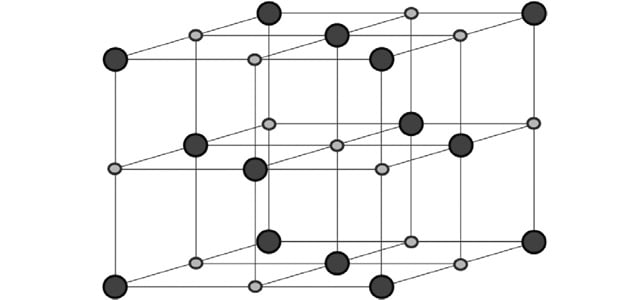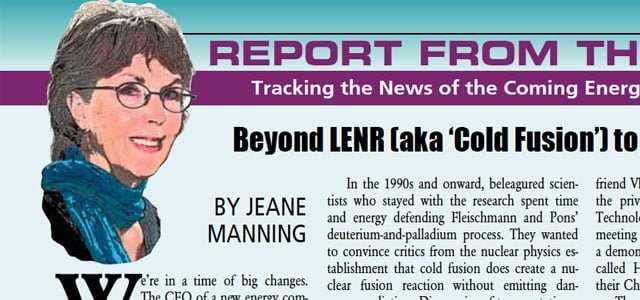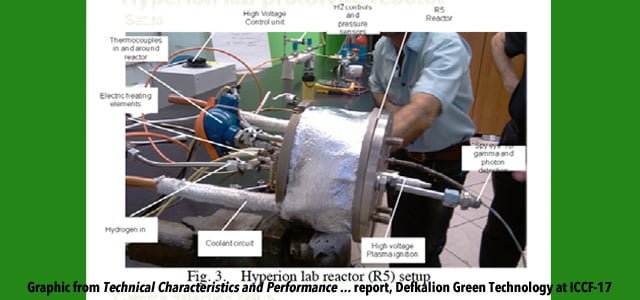Physicist and cold fusion researcher Edward Tsyganov presented his research on low-energy collisions of atoms within a crystal at the Channeling 2012 Conference organized by the Italian National Institute for Nuclear Physics (INFN). A description of this work was summarized in our Q&A A Physicist’s Formula with Tsyganov.
Now, Registration of energy discharge in D + D 4He⁄ reaction in conducting crystals (simulation of experiment) [.pdf] has been published along with the Proceedings of the conference, and Tsyganov had this to say about the results of his research presented in the paper, and in particular, how it relates to Defkalion Green Technologies recent demonstration of the Hyperion R5 reactor:
“In the article presented to your attention here, we simulated the proposed experiment to further elucidate the nature of the process of the so-called cold fusion, which is observed in metallic crystals. We are convinced that in the present experimental evidence does not leave any room to doubt the reality of the existence of this phenomenon. Unfortunately, the negative attitude of the nuclear physics community to this new phenomenon, hastily formulated some 20 years ago in a poor repeatability of experiments of the time, remains dominant today.
It should be noted that the only calorimetric measurements, supporting cold fusion, have not been able to bring the experimenters to a correct explanation of this phenomenon. Help came from the accelerator experiments at low energies. It should be noted that the first cycle of these experiments took place in Japan as early as 1996-2000, but remained virtually unnoticed. Below these works are cited.
H Yuki, T Satoh, T Ohtsuki, T Yorita, Y Aoki, H Yamazaki and J Kasagi “D + D reaction in metal at bombarding energies below 5 keV”, J. Phys. G: Nucl. Part. Phys. 23 (1997) 1459-1464
J. Kasagi, H. Yuki, T. Itoh, N. Kasajima, T. Ohtsuki and A. G. Lipson “Anomalously enhanced d (d, p) t reaction in Pd and PdO observed at very low bombarding energies”, the Seventh International Conference on Cold Fusion, 1998, Vancouver, Canada:, ENECO, Inc., Salt Lake City, UT. : P. 180.
H. Yuki, J. Kasagi, A.G. Lipson, T. Ohtsuki, T. Baba, T. Noda, B.F. Lyakhov, N. Asami “Anomalous Enhancement of DD Reaction …”. JETP Letters, December 1998.
J. Kasagi, H. Yuki, T. Baba and T. Noda “Low Energy Nuclear Fusion Reactions in Solids”, 8th International Conference on Cold Fusion, 2000, Lerici (La Spezia), Italy: Italian Physical Society, Bologna, Italy.
A.G. Lipson, G.H. Miley, A.S. Roussetski, A.B. Karabut “Strong enhancement of dd-reaction …” The work was presented at the ICCF 10 in 2003 and is interesting due to recorded soft X-ray radiation.
Already at the conference ICCF 7 April 1998, Prof. Bressani quite clearly laid out the path to an explanation of the process of cold fusion based on this series of experiments. [See Nuclear Physics Aspects of Cold Fusion Experiments Scientific Summary after ICCF-7 by T. Bressani .pdf.]
Unfortunately, the cold fusion community has not followed the Bressani call; each group had its own theory of the process. In 2002-2009, a similar accelerator experiments at Gran Sasso (Rolfs et al) and Berlin (Czerski et al) successfully produced similar results . References to this work are given in our article. However, even after these experiments very few people realize what all of this might mean.
In our analysis, the only hypothesis which provides sufficient explanation of this “cold fusion” phenomenon , which the traditional nuclear physics community has found difficult to accept, is the assumption that the sub-barrier fusion reactions in the nuclear decay rate of the resulting composite intermediate nucleus is slowing down if the excitation energy of the intermediate nucleus is reducing. In this case, at the thermal energy of the reagents intermediate compound nucleus becomes metastable, and the energy transfer process to the electrons of the crystal lattice through the exchange of so-called virtual photons becomes effective.
If we talk about the DD reaction in metallic crystals, for the practical start of the reaction, we need to fill in all the possible deuterium vacancies in the crystal. When these positions are not filled the reaction is practically not observed. This is due to the vacancy and the extended location of the deuterium atoms from one another. This fact was the main reason for poor repeatability of experiments in the past. As the vacancy is filled with deuterium, the double fillings appear where the fusion process becomes much faster due to the deformation of the electron shells of deuterium in metallic crystals.
To conclude, it is especially important to comment on the recent experiments on the Hyperion reactor, under the direction of John Hadjichristos (ICCF 18). Hadjichristos took an interesting comparison of the process of deformation of the outer electron orbits of the reacting atoms with the detail of the legend of the Trojan horse in the capture of Troy. As was noted earlier in our studies, the deformation of the electron orbits can effectively mask the Coulomb barrier in the fusion reaction at very low (thermal) energy.
An extremely interesting (if confirmed) result of the experiments on the Hyperion is the emergence of strong magnetic fields during the cold fusion reactions. This result often immediately shuts down many theoretical constructions which can only explain the released nuclear energy going directly to the thermal vibrations of the crystalline lattice by nothing short of a magical force. For this reason, the closer look at the current experimental data presented here is so essential.”
—Edward N. Tsyganov
Original text:
Уважаемые коллеги!
В предлагаемой вашему вниманию статье мы провели расчеты предполагаемого эксперимента по дальнейшему выяснению природы процесса так называемого холодного синтеза, наблюдающегося в условиях металлических кристаллов. По нашему убеждению, в настоящее время экспериментальные факты не оставляют места никакому сомнению в реальности существования этого феномена. К сожалению, отрицательное отношение сообщества ядерной физики к этому новому явлению, поспешно сформулированное около 20 лет тому назад в условиях недостаточной повторяемости экспериментов того времени, остается попрежнему доминиружщим.
Нужно отметить, что одни только калориметрические измерения, подтвеждающие холодный синтез, оказались не в состоянии привести экспериментаторов к правильному объяснению этого явления. Помощь пришла со стороны ускорительных экспериментов при низких энергиях. Нужно отметить, что первый цикл этих экспериментов прошел в Японии еще в 1996-2000 гг, но остался практически незамеченным. Ниже приводятся эти работы.
H Yuki, T Satoh, T Ohtsuki, T Yorita, Y Aoki, H Yamazaki and J Kasagi “D+D reaction in metal at bombarding energies below 5 keV”в журнале J. Phys. G: Nucl. Part. Phys. 23 (1997) 1459–1464
J. Kasagi, H. Yuki, T. Itoh, N. Kasajima, T. Ohtsuki and A. G. Lipson “Anomalously enhanced d(d,p)t reaction in Pd and PdO observed at very low bombarding energies”, the Seventh International Conference on Cold Fusion, 1998, Vancouver, Canada:, ENECO, Inc., Salt Lake City, UT. : p. 180.
H. Yuki, J. Kasagi, A.G. Lipson, T. Ohtsuki, T. Baba, T. Noda, B.F. Lyakhov, N. Asami “Anomalous Enhancement of DD Reaction…”. Декабрь 1998 г, письма в ЖЭТФ.
J. Kasagi, H. Yuki, T. Baba and T. Noda “Low Energy Nuclear Fusion Reactions in Solids”, 8th International Conference on Cold Fusion, 2000, Lerici (La Spezia), Italy: Italian Physical Society, Bologna, Italy.
A.G. Lipson, G.H. Miley, A.S. Roussetski, A.B. Karabut “Strong enhancement of dd-reaction…” Работа была доложена на ICCF 10 в 2003 г. Интересна тем, что там регистрировалось мягкое рентгеновское излучение.
Уже на конференции ICCF 7 в апреле 1998 г проф. Брессани достаточно ясно изложил путь к объяснению процесса холодного синтеза, основанный на этой серии экспериментов. К сожалению, сообщество холодного синтеза не последовало призывам Брессани, у каждой группы была своя теория процесса. В 2002-2009 гг успешно прошли аналогичные эксперименты на ускорителях в Гран Сассо (Ролфс и др.) и в Берлине (Черский и др.). Ссылки на эти работы даются в нашей статье. Тем не менее, даже после этого мало кто осознал, что все это может означать.
В нашем рассмотрении единственной гипотезой, которая необходима для объяснения холодного синтеза и с которой традиционным ядерным физикам оказалось трудно согласиться, является предположение о том, что в реакции подбарьерного синтеза скорость распадов образующегося составного промежуточного ядра по ядерным каналам замедляется при уменьшении энергии возбуждения этого ядра. В этом случае при тепловых энергиях реагентов составное промежуточное ядро оказывается метастабильным, и процесс передачи энергии этого ядра электронам кристаллической решетки посредством обмена так называемыми виртуальными фотонами становится эффективным.
Если говорить о реакции DD в металлических кристаллах, то для практического начала реакции нужно заполнить дейтерием все возможные вакансии в кристалле. Пока эти вакансии не заполнены, реакция практически не наблюдается, так как вакансии и, соответственно, атомы дейтерия располагаются достаточно далеко друг от друга. Это обстоятельство являлось главной причиной плохой повторяемости опытов. При дальнейшем заполнении кристалла дейтерием появляются вакансии с двойным заполнением, где процесс синтеза протекает очень быстро из-за деформированности электронных оболочек дейтерия в металлических кристаллах.
Завершая это предисловие, необходимо особенно отметить недавние эксперименты на установке Гиперион под руководством Джона Хаджихристоса (ICCF 18). Хаджихристос приводит интересное сравнение процесса деформации внешних электронных орбит реагирующих атомов внутри кристаллических кристаллов с подробностями легенды о троянском коне при взятии Трои. Как отмечалось в наших первых работах, деформация электронных орбит позволяет эффективно преодолевать кулоновский барьер в реакции синтеза при низких (тепловых) энергиях.
Исключительно интересным результатом (если он подтвердится) экспериментов на установке Гиперион можно назвать возникновение сильных магнитных полей при протекании реакции холодного синтеза. Даже один этот результат Гипериона сразу закрывает многие теоретические построения, в которых выделившаяся ядерная энергия некоторым магическим образом переходит непосредственно в тепловые колебания кристаллической решетки.
С уважением,
Э.Н. Цыганов








